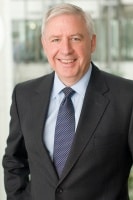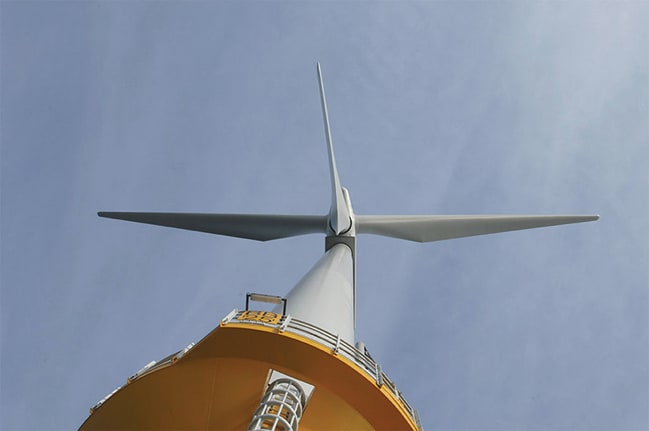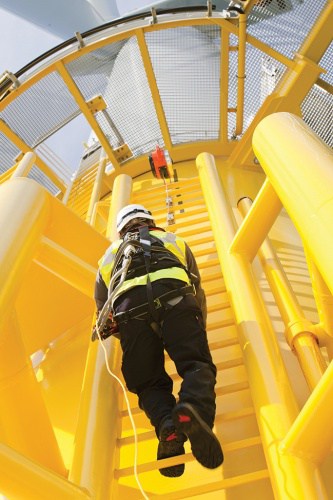
Brent Cheshire
UK chairman, DONG Energy
Managing director, DONG Energy wind power
Education
1976: Durham University, honours degree in geology
Career
1977: Joins Shell International Petroleum as a geologist in exploration and production division. Fourteen years with Shell, including three years at the training centre in The Hague
1991: Joins Amerada Hess, serving in a number of roles, including senior vice-president for E&P Worldwide Technology, where he was responsible for all global technical activities
2004: Becomes DONG Energy’s first UK employee, as managing director of UK E&P Company
2014: Takes on managing director role at DONG wind power and chairmanship
of UK business
Brent Cheshire heads up the organisation responsible for building the UK’s largest offshore wind installations and running most of them, but he freely admits that he came to the industry from a position of scepticism. “I’m an oil and gas geologist, and I worked in the exploration and production business for 37 years,” he told The Engineer. After joining DONG Energy’s E&P business, when he transferred over to head up its wind power division, “I thought well, we have a wind resource in the UK and we have to tap into it, but is it ever going to be serious? Gas has to be the thing to do.”
Cheshire now declares himself a fan of wind. “Being exposed to the nuts and bolts of the wind business over the past 12 months, the load factors are much higher than I had thought, the uptimes are fantastic and the generation is really very good. We have wind farms on the west of the British coast, the east, and obviously we also have them in Denmark and Germany. And one of the things that you see, with that overview, is that there is a real balance. The wind is blowing well at different places and different times, and we’re getting a lot better at predictability.”
”Being exposed to the nuts and bolts of the wind business over the past 12 months, the load factors are much higher than I had thought, the uptimes are fantastic and the generation is really very good
This isn’t to say that intermittency isn’t an issue, he conceded. “There will always be the problem that if you’ve got high pressure and the wind doesn’t blow and it’s a cold day and you haven’t got any solar, then you have a problem and you’re going to need other forms of generation. But in the time I’ve been UK chairman and we’ve built more windfarms offshore, that’s virtually never happened.”
The name DONG Energy is an acronym for Dansk Olie og Naturgas (Danish Oil and Natural Gas, so it works as an acronym in two languages although it’s only amusing in one). The company was formed from a merger between an E&P company and a gas pipeline company, and then a number of Danish electricity companies joined the group, and it is majority owned by the Danish state. Wind is not its biggest business, comprising 12 per cent of its turnover compared with gas as 18 per cent; specialising in deep drilling, it is a major player in developing gas production in the West of Shetland region. It also operates thermal power stations (which are all fuelled by biomass) in Denmark.

However, it’s probably best known in the UK for wind, where it specialises completely in offshore. It was the first major investor in UK offshore wind with the construction of the 30-turbine, 90MW Barrow windfarm in the Irish Sea 7km off the Cumbrian coast, which it built in 2005-6 in partnership with Centrica, and now has 10 operational windfarms around the UK, of which it operates seven; another two, with total capacity of 2.5GW, are under development.
It’s often stated that the UK has the best wind resource in Europe, so why did it take a Danish company — and a state-owned one at that — to develop that capability? Cheshire puts it down to the company’s early start in the sector. “DONG put in its first wind turbines as a company — which is to say one of its constituent companies — about 30 years ago, and they’re still actually running.”
The Danish government had a policy to develop low-carbon generation, as at the time it was dependent on coal imports. “Denmark building an industry was part and parcel of state-regulated utilities, which sowed the seed,” he said, and when it started to expand outside Denmark it looked for a nearby market with a culture its executives felt they understood. Having already developed the world’s first large-scale offshore windfarm, the UK was an obvious target for DONG.
The wind industry has been dogged by scepticism and local opposition in its onshore guise, but Cheshire is adamant that the offshore industry is a very different beast. For a start, it’s windier, to an extent that he believes most people who aren’t familiar with conditions at sea seriously underestimate. “The performance is much better compared to how I would have thought of it in my old sceptical days,” he said.
‘The reliability of the turbines in mechanical terms is fantastic, and more than 90 per cent of the time these things are ready to go. We’re actually generating well in excess of the high 40s, 50 per cent of the time, and those are much higher load factors than people thought.”
DONG sinks considerable resources into making sure that its wind farms are located at suitable sites. “We test the seabed and the windspeeds over a long period of time, and we’re getting a lot more sophisticated about how we measure those wind resources,” said Cheshire.
The way the company approaches siting is evolving, however, as part of a general concern with driving down the cost of wind energy. “Quite a few years ago, we tended to build farms where there was a lot of wind, but we didn’t worry too much about distance from shore or seabed conditions because we could engineer our way out of that,” he said. “And we did, but that costs.”
DONG now uses a model that balances wind speed with distance to shore (the further out, the dearer it is to bring the electricity back) and the seabed conditions, as well as the scale of the windfarm in terms of number and size of turbines. Like much of the wind industry, it is gradually increasing the size of turbine in typical installations, from 3.6MW (about the size of the London Eye) to 6MW units in its new windfarm at Race Bank, 27km north of Blakeney Point on the Norfolk Coast, and 8MW for Burbo Bank 8km offshore in Liverpool Bay, where it is building an extension to an existing facility. An 8MW turbine is 220m tall from sea level to blade tip.
”The reliability of the turbines in mechanical terms is fantastic, and more than 90 per cent of the time these things are ready to go
Other cost-reducing measures include standardising windfarm components such as the substations that handle the electricity. “We have a guy called Mats Vikholm working with us; he was previously with Volvo and he’s well versed in driving down cost from his time in automotive,” said Cheshire, “and he’s also a fierce champion of bringing in local content.” Vikholm, DONG’s head of procurement and cost of electricity, has instituted a process of considering installations in terms of their essential components: onshore substation, export cabling, offshore substation, including the windfarm control system, array cables, foundations and turbines. Each component is optimised and each successive windfarm has to produce demonstrably cheaper electricity than its predecessor.

For offshore substations, DONG moved from building bespoke systems for each installation to working with WS Atkins to design a standardised unit. “Sometimes it’s overengineered for an installation, but on a unit-cost basis it still saves money.”
The goal is to for installations specified in 2020 (which would come on-stream in 2023) to produce electricity at a cost of €100/MWhr. “We expect to hit that,” he said. “The latest units off East Anglia are coming in at about £119.50 [€160], and we’re still reducing that cost.”
Cheshire is pleased that the local content on installations is increasing, up to 50 per cent in terms of value, and also that the installations are benefitting local communities in other ways. For communities that once made their living from fishing, wind power is a good fit, he said.
“The maintenance base we’re establishing in Grimsby for our Westermost Rough windfarm has been very good for the harbour and the port,” he commented. “Centrica and E.on are there as well, and it’s giving a real sense of optimism. Westermost Rough will be 20km offshore, and it’ll give good jobs on boats with training and a line of sight to good careers.”




Nanogenerator consumes CO2 to generate electricity
Whoopee, they've solved how to keep a light on but not a lot else.